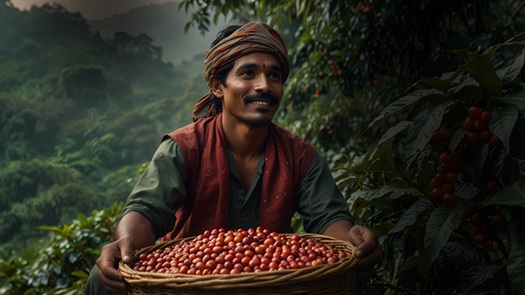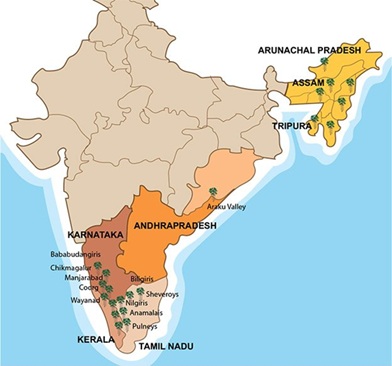(Prelims: Current Issues)
(Mains, General Studies Paper- 3: Major Crops - Cropping Pattern in Different Parts of the Country; Storage, Transportation and Marketing of Agricultural Produce, Related Issues and Constraints) |
Reference
The largest share of India's coffee production comes from Chikkamagaluru, Coorg and Hassan districts of Karnataka. Recently, heavy rains for more than three months in a row, extreme cold and lack of sunlight in these areas have caused severe damage to coffee plantations. It is estimated that coffee production may decline by 20 to 30% this time.

About India's Coffee Heartland
- Karnataka, especially Chikkamagaluru, Coorg and Hassan is considered as India's Coffee Heartland.
- About 70% of the country's total coffee production comes from here. This region is world famous for high quality Arabica and Robusta coffee.

Coffee Production in India
- India's coffee production is mainly in Karnataka, Kerala and Tamil Nadu.
- According to the Coffee Board, the estimated production in the year 2025-26 was 4.03 lakh metric tons, which includes 1.18 lakh tons of Arabica and 2.84 lakh tons of Robusta.
- India is one of the world coffee exporting countries and its coffee goes to many parts of Europe, America and Asia.
Recent Problem: Monsoon Freeze
- Premature and continuous rains in the year 2025 have badly affected coffee production.
- Due to heavy rains and moisture, diseases like black rot, leaf rot, fruit rot, berry drop and stock rot spread. Farmers could not even spray fungicides on time.
Key factors
- Earlier and continuous rains than normal
- Lack of sunlight and heat
- Waterlogging and increased soil moisture
- Failure to implement crop protection measures on time
Effects
- 20-30% drop in coffee production
- Both Arabica and Robusta varieties affected
- Significant reduction in farmers' income
- Subsidiary crops like Pepper Vines also affected
- Negative impact on coffee exports
Challenges
- Continuous weather instability
- Difficulty in disease and pest management
- Waterlogging and loss of soil fertility
- Financial crisis for small farmers
- Competition in the global market
Way forward
- Better techniques for drainage and soil conservation
- Strengthening weather forecasting and crop insurance schemes
- Adoption of scientific and sustainable farming practices
- Technical assistance and relief packages to farmers by Coffee Board and Government
- Farmers Diversification of supporting crops for income security
Conclusion
The coffee heartland of India is currently facing severe climate crisis. If sustainable farming, better water management and government support are promoted, not only will the livelihood of farmers be secured but Indian coffee will also be able to retain its global identity.
|
Coffee as a Crop
Climate
- Coffee thrives in tropical and humid climates.
- Temperatures ranging from 15°C to 28°C are ideal.
- Annual rainfall of 150-250 cm is required.
Agriculture
- Grown under shade trees.
- Red loamy soil, well drained soil is best suited
- Main varieties: Arabica (less caffeine, tastier) and Robusta (more caffeine, harder)
About the Indian Coffee Board
- The Indian Coffee Board is an organisation managed by the Ministry of Commerce and Industry, Government of India to promote coffee production in India.
- Its headquarter is situated in Bengaluru, Karnataka.
- This board was established in 1942 by an Act of Parliament.
- Until the year 1995, Coffee Board used to market coffee of many producers through a joint supply but after that due to economic liberalization in India, coffee marketing became a private sector activity.
- The traditional functions of Coffee Board include promotion, sale and consumption of coffee in India and abroad; conducting coffee research; financial assistance for setting up small coffee producers; protection of working conditions for workers and management of surplus stocks of leftover coffee.
|


